Northeastern United States
 From Nwe
From Nwe 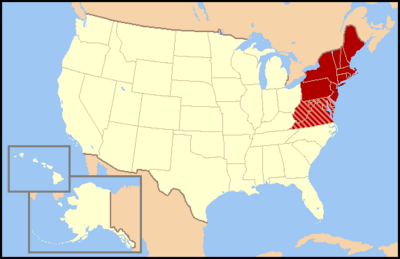
The Northeastern United States, as defined by the U.S. Census Bureau, covers nine states: Maine, New Hampshire, Vermont, Massachusetts, Rhode Island, Connecticut, New York, New Jersey, and Pennsylvania. All were among the original thirteen colonies settled in the seventeenth century (though Maine and Vermont were considered part of other colonies at the time) and joined the United States of America upon independence in 1776.
The first Europeans to settle New England landed in present-day Massachusetts. These settlers were primarily non-conformists (later called Pilgrims) and Puritans from England seeking religious freedom. Massachusetts was also one of the key colonies in the events that led up to the break away from the British Empire. The Battle of Lexington and Concord took place April 19, 1775, when the British sent a regiment to confiscate arms and arrest revolutionaries in Concord, Massachusetts. It was the first fighting of the American Revolution.
The Northeast is bordered to the north by Canada, to the west by the Midwest, to the south by the South, and to the east by the Atlantic Ocean. Its largest city, New York City, is also the largest city and metropolitan area in the United States.
The Northeast is also the richest region of the United States. While they rank high in income, they are predominantly small in overall population and area, with only New York, New Jersey, and Pennsylvania ranking in the top ten states in population and no state ranking in the top ten in size.
Geography
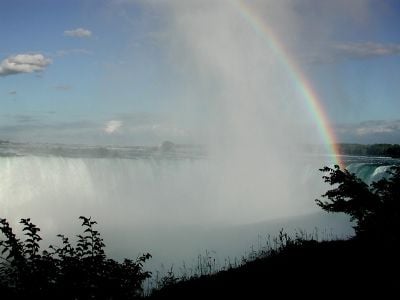
The Northeast is the smallest Census Bureau-defined region in the country though it has the most states. The landscape varies from the rocky coast of New England to the fertile farmland of the Ohio River Valley. Jagged cliffs rise up to a hundred feet above the ocean on Maine's northern coast; south of the state's West Quoddy Head Peninsula, the easternmost point in the United States, the coastline subsides to sandy beaches that extend along the rest of the Northeast's Atlantic coastline. Between Cape Cod in Massachusetts and Cape May in New Jersey are a series of large islands, including Nantucket, Martha's Vineyard, Block Island, Long Island, Manhattan, and Staten Island.
The mouths of four major rivers pierce the coastline to empty into the Atlantic:
- Delaware River: flows south from its source between the Pocono Mountains and the Catskills, forming the border between Pennsylvania and New Jersey and passing through the Trenton and Philadelphia area before emptying into Delaware Bay on the Delaware-New Jersey border;
- Hudson: empties into New York Harbor at the New York-New Jersey border and extends north between the Berkshires and the Catskill Mountains to its source in the Adirondack Mountains;
- Connecticut River: runs along the border of New Hampshire and Vermont between the Green Mountains and White Mountains before flowing through Springfield, Massachusetts, and Hartford, Connecticut, on its way to empty into Long Island Sound.
- Kennebec River: extends over 60 miles (100 km) past Augusta into the thick pine forests of Maine.
- Susquehanna River begins in the Catskill Mountains of New York and winds down a valley between the Allegheny Plateau and the Pocono Mountains in Pennsylvania before crossing the border into Maryland and emptying into the Chesapeake Bay.
To the north and west of the Susquehanna are the Finger Lakes of New York, so called because they resemble human fingers, and the Northeast's borders with the Great Lakes of Lake Ontario in New York and Lake Erie in both Pennsylvania and New York. On an isthmus between the two Great Lakes on the New York-Ontario border, near Buffalo, New York, is one of the most famous waterfalls in the world, Niagara Falls.
In the White Mountains of New Hampshire is Mount Washington, the tallest mountain in the Northeast and the windiest location in the United States. The White Mountains were also the location of the famous geological formation called the Old Man of the Mountain, which collapsed in 2003. To the west of the Green Mountains on the New York-Vermont border, and extending into Canada, is glacier-formed Lake Champlain, which drains north into the St. Lawrence river valley.
To the south, the Ohio River flows from the Allegheny Plateau through Pittsburgh and on into the Midwest, where it merges with the Mississippi River. The Ohio was one of the main routes of travel west in early American history.
Climate
The northeastern states possess a wide range of climates. Rainfall varies from over 50 inches annually in some coastal areas to 32 inches in the western part of Pennsylvania and New York. Snowfall can range from over 100 inches per year in Upstate New York to only trace amounts in the coastal areas of Maryland. Generally, northern New England, the parts of New York north of the Mohawk River, highland areas in the Appalachians, and some coastal areas have warm, humid summers and snowy, often bitterly cold winters.
Below this line, much of the region (except for the higher elevations) has hot, humid summers and moderately cold, snowy winters. Most of the major cities of the Northeast lie within this zone, including Pittsburgh, New York, and Boston. The area around the Chesapeake Bay, (as well as the states of Maryland, Delaware, and extreme southeastern Pennsylvania) has hot, humid summers and more mild winters.
History
New England
New England has more of a shared heritage than other regions of the country. It has played a dominant role in American history. From the late seventeenth century to the late eighteenth century, New England was the nation's leader in politics, education, culture, and intellectual thought as well as the country's economic center.
The earliest European settlers of New England were English Protestants who came in search of religious liberty. They gave the region its distinctive political format — town meetings (an outgrowth of meetings held by church elders), in which citizens gathered to discuss issues of the day. Town meetings still function in many New England communities and have been revived as a form of dialog in the national political arena.
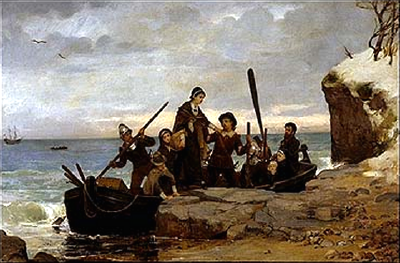
The cluster of top-ranking universities and colleges in New England—including four of the eight schools of the Ivy League, as well as the Massachusetts Institute of Technology (MIT), Tufts University, and numerous other elite colleges and universities—is unequaled by any other region. America's first college, Harvard, was founded at Cambridge, Massachusetts, in 1636 as a church school. Many of the graduates from these schools end up settling in the region, providing the area with a well-educated populace.
As some of the original New England settlers migrated westward, immigrants from Canada, Ireland, Italy, and eastern Europe moved into the region. Despite a changing population, New England maintains a distinct cultural identity. New England is also well known for its mercurial weather and vibrantly colored foliage in autumn. The extreme southwestern part of Connecticut is sometimes considered culturally and demographically more like the Mid-Atlantic region because of its proximity to New York City.
Mid-Atlantic
This area provided the young United States with heavy industry and served as the "melting pot" of new immigrants from Europe. Cities grew along major shipping routes and waterways, including New York City on the Hudson River and Philadelphia on the Delaware River.
Dutch immigrants moved into the lower Hudson River Valley in what is now New Jersey and New York in the early seventeenth century. An English Protestant sect, the Religious Society of Friends (Quakers), led by William Penn, settled Pennsylvania. His colony gave equal right to people from different races and religions. In time, all these settlements fell under English control, but the region continued to be a magnet for people of diverse nationalities.
Early settlers were mostly farmers and traders, and the region served as a bridge between North and South. Philadelphia, Pennsylvania, midway between the northern and southern colonies, was home to the U.S. Continental Congress, the convention of delegates from the original colonies that organized the American Revolution. It was also the birthplace of the Declaration of Independence in 1776 and the U.S. Constitution in 1787.
With two of America's largest cities, New York and Philadelphia, the region is a major center of business, media, education, the arts, and cuisine. Though initially settled by Europeans, the region now boasts large Asian and Hispanic populations. African immigrants have many strongholds in urban areas.
Culture
Religion
While some regions of the United States, such as the South, are predominantly Protestant, half of the states in the Northeast are predominantly Roman Catholic. This is largely due to substantial levels of immigration the region received in the nineteenth and early twentieth centuries from Ireland, Italy, Quebec, and other Catholic regions. The Northeast is also home to many other religious groups. It has the largest concentration and percentage of Jews in the United States.
The region also has the highest number of Hindus and Sikhs in the nation. This is due to the fact that the Northeast has more people of Indian descent than any other part of the country, and in the world outside India.
The region is also home to one of the largest populations of Muslims, Buddhists, and many other religions, including the highest amount of Roman Catholics and Eastern Orthodox Christians, due to the many Eastern Europeans who have immigrated to the region.
Ethnicity
The Northeast is an ethnically diverse region. It contains the highest concentration of Italian-Americans and Irish-Americans in the United States and high numbers of African-Americans, Hispanics, and Asians. It has a generally low number of Native Americans.
The high level of diversity has much to do with New York City, which was and still is an entry point for many immigrants; however, the other major cities of the region have significant ethnic diversity as well. The three largest cities in the Northeast (New York City, Philadelphia, and Boston) have the same four largest ancestries: African American, Italian, Irish, and Puerto Rican.
As is the case in much of the United States, people from many European American backgrounds live in the Northeast, although white northeasterners frequently identify with their ethnic background more strongly than do U.S.-born whites from other U.S. regions. Massachusetts, particularly in the Boston area, is regarded as the Irish capital of the United States. New York City, Philadelphia, Baltimore, and New Jersey have long been known for their large populations of Italian-Americans, many of whom have moved to outlying suburban areas. The New York City Borough of Brooklyn historically is a major center of the Jewish-American population; while a significant community still lives there, in the mid-twentieth century Jews made up over 50 percent of the borough's white population (the city as a whole contained over 50 percent of the entire country's Jewish population at the time).
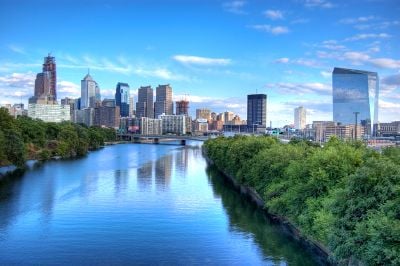
Lancaster County, Pennsylvania, is the center of the area settled by the Amish (who are of Swiss German descent), but now a large, vibrant Hispanic population lives there as well. Overall, the Northeast has a high percentages of people of Jewish, German, Italian, Irish, Portuguese, and French-Canadian descent.
The Northeast has the second largest Asian population in the United States, after the West Coast. The largest of these groups are Indian, Chinese, Korean, and Filipino, in that order. There are also significant populations of Japanese, Vietnamese, Thais, and Cambodians.
Almost all the Asians are concentrated in New York, Pennsylvania, New Jersey, and Massachusetts. However, Connecticut and Delaware are seeing a rapid surge in Asians.
The Northeast has the third largest Hispanic population, after the West Coast and the Southwest. The majority of the nation's Puerto Ricans reside in the region, chiefly in the states of New York, Pennsylvania, New Jersey, Massachusetts, and Connecticut. Also, the Northeast has the most people of "Other Hispanic" heritage in the country, with the majority of them being Dominican, Central American, and Colombian. The Northeast also has the second-largest population of Cuban Americans of any region, but their concentration is more widespread (the South has the largest Cuban population, but it is almost completely concentrated in southern Florida). Hudson County, New Jersey, has the highest Cuban population outside southern Florida. The neighborhood of Washington Heights in Manhattan is regarded as the center of the Dominican diaspora, and Paterson, New Jersey, is the center of Peruvian immigration.
While the Northeast has one of the smallest populations of Mexican Americans of any U.S. region, its Mexican population is growing at a faster rate than that of any other region in the country, and there are many cities and towns with significant populations.
The Northeast also has the second largest population of African-Americans, only behind the South. Most of the black population resides in New York, Pennsylvania, or New Jersey. New York has more blacks than any other state, Pennsylvania is ranked tenth in number of African Americans, and New Jersey is ranked fifteenth. Massachusetts and Connecticut also have large black populations. The Northeast also contains the bulk of the African immigrant population in the United States.
While much of the region is highly diverse, the Northeast also contains the three states with the highest percentage of European Americans: Maine, Vermont, and New Hampshire. These three states all have high concentrations of French Canadians and many descendants of English immigrants.
Cuisine
The Northeast has from colonial times relied on fishing and seafaring as a major source of its economic strength. The result has been an intensely developed seafood sector, which produces some of the most famous dishes in the world. Maine's excellent lobster is shipped around the nation. Boston, one of the oldest seaports in America, makes what the locals consider the finest clam chowder. New England is also famous for fried and steamed clams.
The region's large immigrant populations have contributed to a mixture of tastes mingling.
Urban and suburban
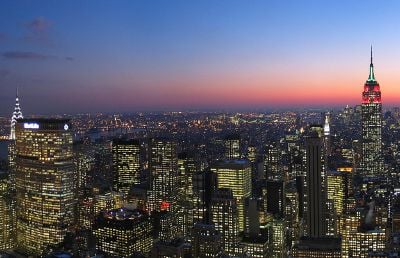
Much of the history of the Northeast is characterized by archetypical medium and large manufacturing cities. The sometimes urban character of the region gives it a strange mix of reputations, and many view Northeastern cities as places of economic opportunity. In major northeastern cities, ethnic enclaves are not uncommon. Most of the cities have large artistic and theatrical scenes.
At the same time, major cities are expensive and have large economic disparities. The decreased importance of manufacturing has left many of the cities without an economic base, giving some of them a reputation for urban decay. Notable examples of cities left damaged and often severely depopulated from loss of manufacturing include Yonkers, Utica, Buffalo, Syracuse, and even parts of New York City in New York State; Newark in New Jersey; Lowell in Massachusetts; Hartford and Bridgeport in Connecticut; and Pittsburgh in Pennsylvania. However, examples dot the entire region and much of the neighboring region of the Midwest.
Some of these cities have enjoyed revivals in recent years, replacing their economic reliance on manufacturing with job development in the medical, technical, and educational industries. Pittsburgh, for example, now counts only 23 percent of its workforce in blue-collar occupations, according to a 2005 report from the Bureau of Labor Statistics. The last of the city's steel mills closed in 1998.
Though it generally is seen as having a very urban character, at least in its most populated areas, the Northeast was one of the first regions to undergo heavy post-World War II suburbanization. The most notable of these early suburbs was Levittown, east of New York City, built in the late 1940s and early 1950s to provide homes for returning soldiers. Today, suburbanization is a rampant trend in United States housing development, driven by widespread use of the automobile. Many of the major and secondary cities in the region also utilize mass transit.
The Northeast as a megalopolis
Today, the coastal Northeast is said to resemble a megalopolis, or megacity, an interdependent network of cities and suburbs that blend into each other. Economically, the region provides many of the financial and government services the rest of the country and much of the world depends on, from New York's Wall Street to Boston's academia. It is linked largely by the I-95 Interstate, which runs from Florida through Philadelphia, New York, and Boston and into Maine. By rail, the cities are linked by Amtrak's Northeast Corridor. Suburbs of Boston as far north as New Hampshire and even Maine, as well as Washington, D.C.'s suburbs in Virginia are arguably all part of this megacity.
Despite the heavy urban/suburban characteristics of the region, many rural characteristics survive. Much of Upstate New York has decidedly rural characteristics. The Pine Barrens in southern New Jersey as well as the northwestern part of the state are known as retreats from the urban areas of the Northeast. New York is a heavily agricultural state, and even New York City's boroughs of Queens and Staten Island had some sort of farm production well into the late twentieth century. Small towns and cities dot western Massachusetts' Berkshire region, as well as Vermont, Pennsylvania, and New Hampshire. While formerly important rural industries like farming and mining have decreased in importance in recent decades, they persist.
Economy
Until World War II, the Northeast's economy was largely driven by industry. In the second half of the twentieth century, most of New England's traditional industries have relocated to states or foreign countries where goods can be made more cheaply. In more than a few factory towns, skilled workers have been left without jobs. The gap has been partly filled by the microelectronics, computer, and biotechnology industries, fed by talent from the region's prestigious educational institutions.
Like New England, the Mid-Atlantic region has seen much of its heavy industry relocate elsewhere. Other industries, such as drug manufacturing and communications, have taken up the slack.
As the service sector is less dependent on heavy labor than the formerly dominant industrial sector, the incentive that unskilled laborers and immigrants once had to move to the Northeast has largely diminished. They lack the skills to compete in, for example, the financial, technical, educational, and medical markets. However, the Northeast remains a magnet for skilled workers from around the world.
Politics
The Northeast region is known for its political liberalism. For example, every state in the region voted for John Kerry in the 2004 presidential election. Pennsylvania, however, is considered a state that either a Republican or Democratic presidential candidate could win.
Historical
Traditionally, the Northeast was a Republican stronghold. During the late nineteenth century and early twentieth century, the Republicans were economically and socially liberal, advocating open markets and endorsing the concept of free labor (a belief that laborers have the right to sell their labor in exchange for wages); therefore, the Republicans of the time generally opposed labor unions and slavery. From the American Civil War until the Great Depression, U.S. politics was largely dominated by Northeastern Republicans and their business interests. The wealth and power of the Northeast during this period generated a great deal of animosity in other regions of the country with more agrarian interests, in part because of Republican domination. Some of that animosity persists.
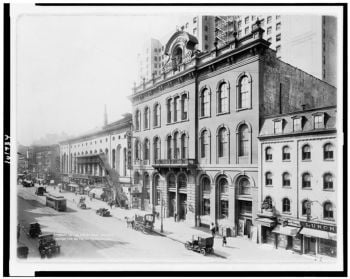
The major cities were more likely to support the rival Democratic Party and often were under the control of the powerful political machines that dished out patronage (the most famous of these machines was Tammany Hall in New York City, which held some political power into the 1960s). Immigration to Northeastern cities rapidly pushed the population of the region upward from the 1790s until World War II, and the Democratic Party often won the support of these immigrants through political patronage.
From the 1930s to the early 1990s, despite the power of labor unions, the Democratic Party was regarded as "too economically illiberal" (that is, supportive of heavy government interference in the economy and overly supportive of social programs) for a region that had a large professional class. After World War II, many professionals relocated to suburbs, causing them to take on decidedly Republican leanings as the cities remained largely Democratic enclaves. As a result, the Republicans remained competitive in the Northeast during much of the remainder of the twentieth century. When the Democrats began softening their economic policies in the early 1990s, suburban Northeastern voters responded favorably and became more supportive of them.
Present
Since the late twentieth century, the region's politics have been largely explained by a strong coalition of demographics predominant in the North that are overwhelmingly Democratic. These groups include the majority Catholic population with a significant urban, Democratic legacy (this would apply to the Jewish population as well); artists, educators, and intellectuals of the major cities; the large minority populations of those same cities; a large socially conservative but economically liberal blue-collar population throughout the region; and the often socially liberal suburbanites of New Jersey, Connecticut, and New Hampshire. Pro-business policies espoused by the national Democratic Party since the election in 1992 have drawn many upper-class white professionals into the Democratic fold who would have been Republicans as late as the 1980s.
Ideological differences have softened between city and suburb in recent decades, strengthening the Democratic Party overall. Over time, residents of the suburbs have begun facing challenges once regarded as uniquely urban: street gangs, urban crowding, and drug abuse, while becoming increasingly ethnically diverse.
Postwar migration patterns weakened the Northeast's economic power considerably. Industry often relocated to the West Coast and South regions which were less expensive, less crowded, and were less prone to unionization. By the 1970s, California had surpassed New York as the most populous state, and by 1994 Texas had pushed New York to third place. While New York City remains by far the largest city in the United States and a large recipient of immigrants, most immigration now comes from Latin America to border states such as Arizona, Texas, California, and New Mexico. Secondary cities in the Northeast, like Buffalo, never regained their economic foothold after the decline of industry, though larger and more famous cities such as New York, Boston, and Philadelphia developed sophisticated service economies.
References
ISBN links support NWE through referral fees
- Alexander, Lewis M. The Northeastern United States. New York: Van Nostrand Reinhold, 1976. ISBN 978-0442297497
- Gottmann, Jean. Megalopolis: The Urbanized Northeastern Seaboard of the United States. Literary Licensing, LLC., 2012. ISBN 978-1258416836
- Raymo, Chet, and Maureen E. Raymo. Written in Stone: A Geological and Natural History of the Northeastern United States. Chester, CT: Globe Pequot Press, 1989. ISBN 978-0871066800
Credits
New World Encyclopedia writers and editors rewrote and completed the Wikipedia article in accordance with New World Encyclopedia standards. This article abides by terms of the Creative Commons CC-by-sa 3.0 License (CC-by-sa), which may be used and disseminated with proper attribution. Credit is due under the terms of this license that can reference both the New World Encyclopedia contributors and the selfless volunteer contributors of the Wikimedia Foundation. To cite this article click here for a list of acceptable citing formats.The history of earlier contributions by wikipedians is accessible to researchers here:
- Northeastern United States history
The history of this article since it was imported to New World Encyclopedia:
- History of "Northeastern United States"
Note: Some restrictions may apply to use of individual images which are separately licensed.
↧ Download as ZWI file | Last modified: 02/03/2023 19:42:15 | 34 views
☰ Source: https://www.newworldencyclopedia.org/entry/Northeastern_United_States | License: CC BY-SA 3.0
 ZWI signed:
ZWI signed: KSF
KSF